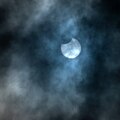Solar eclipse of June 10, 2021: Difference between revisions
Brateevsky (talk | contribs) →External links: +photo of annular eclipse |
mNo edit summary |
||
| Line 14: | Line 14: | ||
File:Partial Solar Eclipse, 10 June 2021 (51237879346) (cropped).jpg|[[Halifax, Nova Scotia|Halifax]], [[Canada]], 8:57 UTC |
File:Partial Solar Eclipse, 10 June 2021 (51237879346) (cropped).jpg|[[Halifax, Nova Scotia|Halifax]], [[Canada]], 8:57 UTC |
||
File:Sunrise Eclipse 2021 (51238283186).jpg|[[Montpelier, Vermont]], 9:33 UTC |
File:Sunrise Eclipse 2021 (51238283186).jpg|[[Montpelier, Vermont]], 9:33 UTC |
||
File:Partial Solar Eclipse June 2021.jpg|[[Danielson, Connecticut]], 9:35 UTC |
|||
File:Partial Solar Eclipse (NHQ202106100004).jpg|[[Lewes, Delaware]], 9:42 UTC |
File:Partial Solar Eclipse (NHQ202106100004).jpg|[[Lewes, Delaware]], 9:42 UTC |
||
File:10-6-2021 solar eclipse from Exeter, England (1).jpg|[[Exeter, England]], 9:40 UTC |
File:10-6-2021 solar eclipse from Exeter, England (1).jpg|[[Exeter, England]], 9:40 UTC |
||
Revision as of 13:09, 12 December 2021
| Solar eclipse of June 10, 2021 | |
|---|---|
 Partial from Halifax, Canada | |
| Type of eclipse | |
| Nature | Annular |
| Gamma | 0.9152 |
| Magnitude | 0.9435 |
| Maximum eclipse | |
| Duration | 231 s (3 min 51 s) |
| Coordinates | 80°48′N 66°48′W / 80.8°N 66.8°W |
| Max. width of band | 527 km (327 mi) |
| Times (UTC) | |
| Greatest eclipse | 10:43:07 |
| References | |
| Saros | 147 (23 of 80) |
| Catalog # (SE5000) | 9555 |
An annular solar eclipse occurred on June 10, 2021, when the Moon passed between Earth and the Sun, thereby partly obscuring the image of the Sun for a viewer on Earth. During the eclipse, the Moon's apparent diameter was smaller than the Sun's, so it caused the Sun to look like an annulus. The annular eclipse was visible from parts of northeastern Canada, Greenland, the Arctic Ocean (passing over the North Pole),[1] and the Russian Far East, whilst the eclipse appeared partial from a region thousands of kilometres wide, which included northeastern North America, most of Europe, and northern Asia.[2]
Path
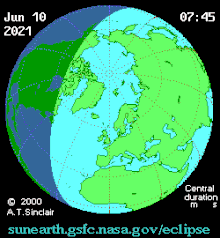
The annular eclipse started at 09:55 UTC for 3 minutes 37 seconds along the northern shore of Lake Superior in Ontario, Canada. The path of the antumbral shadow then headed across Hudson Bay through northwestern Quebec and the Hudson Strait to Baffin Island in Nunavut, where the town of Iqaluit saw 3 minutes and 5 seconds of annularity. After this, it then travelled across Baffin Bay and along the northwestern coast of Greenland, where the point of greatest eclipse occurred at 10:41 UTC in Naires Strait for 3 minutes 51 seconds. The shadow then crossed Ellesmere Island and the Arctic Ocean, passing over the North Pole (which was located away from the central line of the eclipse but saw 2 minutes and 36 seconds of annularity), before heading south towards northeastern Siberia, where the city of Srednekolymsk saw 3 minutes and 35 seconds of annularity at 11:27 UTC. Shortly afterwards, the central line of the annular eclipse ended at 11:29 UTC.[3][4]
Gallery
-
Eclipse over the Statue of Liberty in New York City
-
Montpelier, Vermont, 9:33 UTC
-
Danielson, Connecticut, 9:35 UTC
-
Lewes, Delaware, 9:42 UTC
-
Exeter, England, 9:40 UTC
-
Arlington, Virginia, 9:56 UTC
-
Logroño, Spain, 10:10 UTC
-
Projection from Prague, Czechia, 10:24 UTC
-
Haut-Doubs, France, 10:26 UTC
-
Heidelberg, Germany, 10:30 UTC
-
Projection through leaves in Woerden, Netherlands, 10:30 UTC
-
Brastad, Sweden, 10:32 UTC
-
Lino Lakes, Minnesota, 10:33 UTC
-
Berlin, Germany, 10:38 UTC
-
Saint Petersburg, Russia, 11:09 UTC
-
Partial from Tõrva, Estonia
-
Petrozavodsk, Russia, 11:27 UTC, Coronado telescope
-
Timelapse-video from Akademgorodok, Novosibirsk, Russia
-
Timelapse-video from Kharbalakh, Yakutia, Russia
Related eclipses
Other eclipses in 2021
- A total lunar eclipse on May 26.
- A partial lunar eclipse on November 19.
- A total solar eclipse on December 4.
Tzolkinex
- Preceded: Solar eclipse of April 29, 2014
- Followed: Solar eclipse of July 22, 2028
Half-saros cycle
- Preceded: Lunar eclipse of June 4, 2012
- Followed: Lunar eclipse of June 15, 2030
Tritos
- Preceded: Solar eclipse of July 11, 2010
- Followed: Solar eclipse of May 9, 2032
Triad
- Preceded: Solar eclipse of August 10, 1934
- Followed: Solar eclipse of April 11, 2108
Solar eclipses of 2018–2021
This eclipse is a member of a semester series. An eclipse in a semester series of solar eclipses repeats approximately every 177 days and 4 hours (a semester) at alternating nodes of the Moon's orbit.[5]
The partial solar eclipses on February 15, 2018 and August 11, 2018 occur in the previous lunar year eclipse set.
| Solar eclipse series sets from 2018 to 2021 | ||||||
|---|---|---|---|---|---|---|
| Ascending node | Descending node | |||||
| Saros | Map | Gamma | Saros | Map | Gamma | |
117 Partial in Melbourne, Australia |
July 13, 2018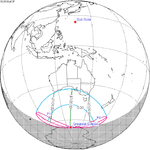 Partial |
−1.35423 | 122 Partial in Nakhodka, Russia |
January 6, 2019 Partial |
1.14174 | |
127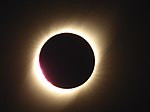 Totality in La Serena, Chile |
July 2, 2019 Total |
−0.64656 | 132 Annularity in Jaffna, Sri Lanka |
December 26, 2019 Annular |
0.41351 | |
137 Annularity in Beigang, Yunlin, Taiwan |
June 21, 2020 Annular |
0.12090 | 142 Totality in Gorbea, Chile |
December 14, 2020 Total |
−0.29394 | |
147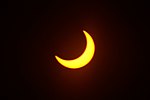 Partial in Halifax, Canada |
June 10, 2021 Annular |
0.91516 | 152 From HMS Protector off South Georgia |
December 4, 2021 Total |
−0.95261 | |
Saros 147
This eclipse is a part of Saros series 147, repeating every 18 years, 11 days, and containing 80 events. The series started with a partial solar eclipse on October 12, 1624. It contains annular eclipses from May 31, 2003 through July 31, 2706. There are no hybrid or total eclipses in this set. The series ends at member 80 as a partial eclipse on February 24, 3049. Its eclipses are tabulated in three columns; every third eclipse in the same column is one exeligmos apart, so they all cast shadows over approximately the same parts of the Earth.
The longest duration of annularity will be produced by member 38 at 9 minutes, 41 seconds on November 21, 2291. All eclipses in this series occur at the Moon’s ascending node of orbit.[6]
| Series members 11–32 occur between 1801 and 2200: | ||
|---|---|---|
| 11 | 12 | 13 |
 January 30, 1805 |
 February 11, 1823 |
 February 21, 1841 |
| 14 | 15 | 16 |
 March 4, 1859 |
 March 15, 1877 |
 March 26, 1895 |
| 17 | 18 | 19 |
 April 6, 1913 |
 April 18, 1931 |
 April 28, 1949 |
| 20 | 21 | 22 |
 May 9, 1967 |
 May 19, 1985 |
 May 31, 2003 |
| 23 | 24 | 25 |
 June 10, 2021 |
 June 21, 2039 |
 July 1, 2057 |
| 26 | 27 | 28 |
 July 13, 2075 |
 July 23, 2093 |
 August 4, 2111 |
| 29 | 30 | 31 |
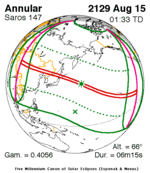 August 15, 2129 |
 August 26, 2147 |
 September 5, 2165 |
| 32 | ||
 September 16, 2183 | ||
Inex series
This eclipse is a part of the long period inex cycle, repeating at alternating nodes, every 358 synodic months (≈ 10,571.95 days, or 29 years minus 20 days). Their appearance and longitude are irregular due to a lack of synchronization with the anomalistic month (period of perigee). However, groupings of 3 inex cycles (≈ 87 years minus 2 months) comes close (≈ 1,151.02 anomalistic months), so eclipses are similar in these groupings.
In the 19th century:
- Solar saros 140: total solar eclipse of October 29, 1818
- Solar saros 141: annular solar eclipse of October 9, 1847
- Solar saros 142: total solar eclipse of September 17, 1876
| Inex series members between 1901 and 2100: | ||
|---|---|---|
 August 30, 1905 (Saros 143) |
 August 10, 1934 (Saros 144) |
 July 20, 1963 (Saros 145) |
 June 30, 1992 (Saros 146) |
 June 10, 2021 (Saros 147) |
 May 20, 2050 (Saros 148) |
 May 1, 2079 (Saros 149) |
1 | |
In the 22nd century:
- Solar Saros 150: Partial solar eclipse of April 11, 2108
- Solar Saros 151: Annular solar eclwssipse of March 21, 2137
- Solar Saros 152: Total solar eclipse of March 2, 2166
- Solar Saros 153: Annular solar eclipse of February 10, 2195
0ü000ü
Metonic series
The metonic series repeats eclipses every 19 years (6939.69 days), lasting about 5 cycles. Eclipses occur in nearly the same calendar date. In addition, the octon subseries repeats 1/5 of that or every 3.8 years (1387.94 days). All eclipses in this table occur at the Moon's ascending node.
| 20 eclipse events between June 10, 1964 and August 21, 2036 | ||||
|---|---|---|---|---|
| June 10–11 | March 28–29 | January 14–16 | November 3 | August 21–22 |
| 117 | 119 | 121 | 123 | 125 |
 June 10, 1964 |
 March 28, 1968 |
 January 16, 1972 |
 November 3, 1975 |
 August 22, 1979 |
| 127 | 129 | 131 | 133 | 135 |
 June 11, 1983 |
 March 29, 1987 |
 January 15, 1991 |
 November 3, 1994 |
 August 22, 1998 |
| 137 | 139 | 141 | 143 | 145 |
 June 10, 2002 |
 March 29, 2006 |
 January 15, 2010 |
 November 3, 2013 |
 August 21, 2017 |
| 147 | 149 | 151 | 153 | 155 |
 June 10, 2021 |
 March 29, 2025 |
 January 14, 2029 |
 November 3, 2032 |
 August 21, 2036 |
References
- ^ JavaScript Solar Eclipse Explorer - Europe (Latitude: 90° 00' 00" N. Longitude: 0° 00' 00" W). NASA
- ^ "NASA - Annular Solar Eclipse of 2021 June 10". eclipse.gsfc.nasa.gov. Retrieved June 10, 2021.
- ^ "EclipseWise - Eclipses During 2021". www.eclipsewise.com. Retrieved June 10, 2021.
- ^ "Кольцеобразное солнечное затмение 10 июня 2021 года | Календарь наблюдателя | Meteoweb.ru". meteoweb.ru. Retrieved June 10, 2021.
- ^ van Gent, R.H. "Solar- and Lunar-Eclipse Predictions from Antiquity to the Present". A Catalogue of Eclipse Cycles. Utrecht University. Retrieved October 6, 2018.
- ^ "NASA - Catalog of Solar Eclipses of Saros 147". eclipse.gsfc.nasa.gov.









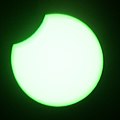

![Haut-Doubs [fr], France, 10:26 UTC](http://upload.wikimedia.org/wikipedia/commons/thumb/5/5a/Solar_eclipse_of_2021_June_10%2C_Haut-Doubs_-_dsmm05747.jpg/120px-Solar_eclipse_of_2021_June_10%2C_Haut-Doubs_-_dsmm05747.jpg)


